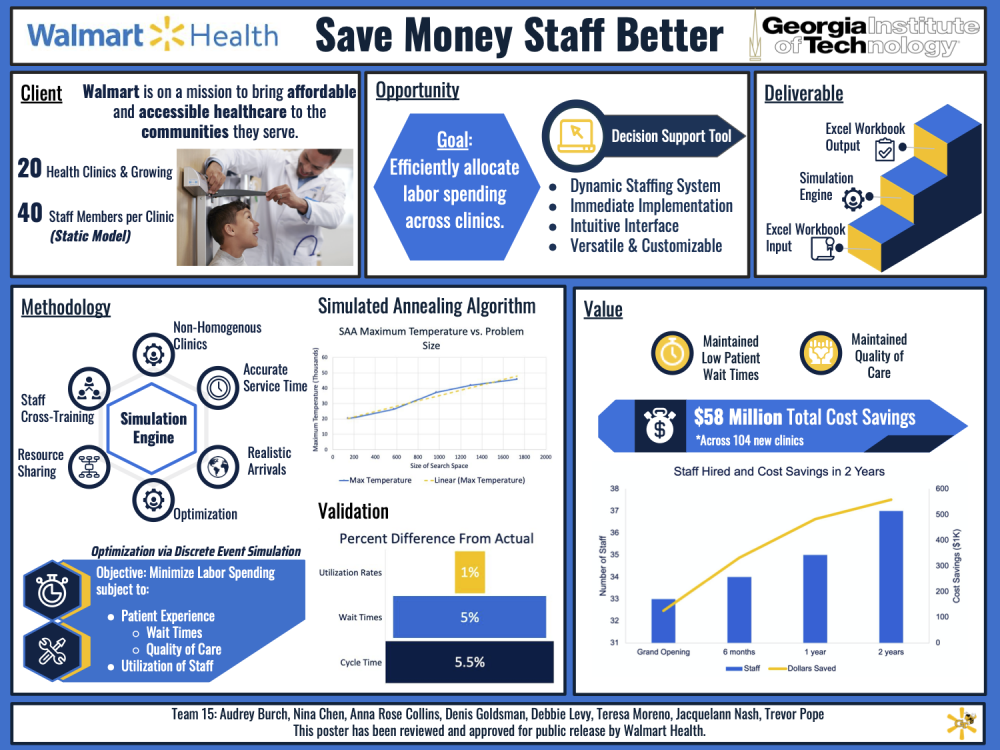Client Context
Walmart Health’s mission is bringing communities affordable and accessible healthcare, and this has been the backbone of our work this semester. Walmart Health offers a variegated array of services ranging from Primary Care, Counseling, Optometry, Diagnostic Imaging & Radiology, Labs and Dental care, all in one convenient health clinic. Currently, Walmart Health has 20 health clinics open across America with a concentration in Georgia, with others open in Arkansas and Illinois. Walmart Health’s initiative is rapidly growing, with plans to expand across the United States. Currently, Walmart Health uses a static staffing model meaning that regardless of the demand for a specific location, approximately 40 staff members are hired at the grand opening of a new clinic.
Project Objective
The 40 hired staff can run a full-scale clinic, but the number of patients walking through the door each day is not equivalent to full operation numbers as clinics build their client base. This has led to underutilization of staff, with staff utilization at about only 18% on average across all open clinics during the first six months of operation (known as Grand Opening). Target utilization rates should ideally be much higher than the current utilization, with a maximum utilization threshold defined at 85% by the client. Labor waste cost is defined as a staff member’s salary multiplied by the difference between actual and target utilization rates.
Walmart Health’s goal is to expand its services to new areas to provide affordable care to as many people as possible. The waste cost resulting from underutilized staff, due to low patient demand at grand opening and a static staffing model, could instead be put back into the system to contribute to the further expansion of the healthcare initiative. Another major goal of Walmart is to maintain the patient experience with a direct correlation to lower wait time; money saved from moving toward a dynamic staffing system could be spent finding new ways to bring quality service to patients. The labor waste costs add up significantly with Walmart Health’s expansion goal, solidifying the need for a dynamic staffing system.
Our goal was to help Walmart Health reduce staffing costs due to underutilization of staff while maintaining the patient experience, through the creation of a dynamic staffing model that uses demand to make decisions. Specifically, the opportunity of this project was to create a Staffing Decision Support Tool that gives Walmart Health the ability to make informed decisions that are dynamic and tailored to a clinic’s demographic needs and specific demand.
We gauged success of our staffing decisions by studying the utilization rates of our solution, and determined if they were closer to target levels for each staff type. Our client emphasizes a patient-centric service, so we maintained specified limitations on patient wait times in our solution.
Design Strategy
The Staffing Decision Support Tool was designed to model a unique clinic, and return the optimal staffing level for any demand. Simulation-based optimization was the chosen method in order to have the most control in modeling the flow of a clinic due to its complex nature.
There are several things our simulation engine took into consideration; we included liberties in staffing decisions such as the possibility for cross-training and resource sharing. With a goal to reduce staffing costs, we included an optimization model that finds the best staffing level at a given demand. We accurately mapped arrival processes and fit distributions to our service times. Additionally, we addressed variability among different clinics.
Through the use of Python for simulation and a Simulated Annealing Algorithm for staffing optimization, we were able to compare the waiting times, utilization rates, and cycle times of our model to real-world values for validation. Utilization rates were within 1%, wait times were within 5%, and cycle times were within about 5.5%. We also compared the Python outputs to a preliminary Simio model and found they were consistent as well, meaning any results presented to our client are ones in which we are confident.
The next component of our design strategy was to ensure the client could use our tool easily without touching any code, allowing for quick implementation. We developed a desktop application that runs the simulation seamlessly by uploading an comprehensive Input Excel Workbook, where the user can input clinic details such as appointment demand. The Input Workbook is uploaded to the simulation engine, which when run, returns a summary Excel workbook detailing the staff utilization rates, waste costs, and patient wait times at the identified optimal staffing level.
Deliverables
The main project deliverable is the Staffing Decision Support Tool. This tool has the capacity to suggest the optimal hiring levels for each staff type, based on historical and forecasted demand. The tool provides statistics such as expected patient wait times, staff utilization rates, and waste costs at the optimal staffing level. Additionally, these statistics are also reported to compare the trade-off of hiring one fewer or one more than optimal. This supports Walmart Health’s decision making rather than providing the “one best answer”.
The tool also has the ability to provide wait time, utilization, and waste cost statistics for any specified staffing level, allowing the client to study different staffing levels. With this capability the client can experiment with sharing staff between clinics, where the tool outputs a report workbook detailing daily staff utilization rates and wait times across all nearby clinics which are candidates for resource sharing.
The client will also receive a Manual that details the functionality of every aspect of the tool. The Manual ensures Walmart Health can successfully use all of the tool’s capabilities to determine staffing levels that are tailored to a clinic’s unique demand.
The last deliverable for our client are process flow maps of staff/patient encounters during appointments for the different lines of services offered.


